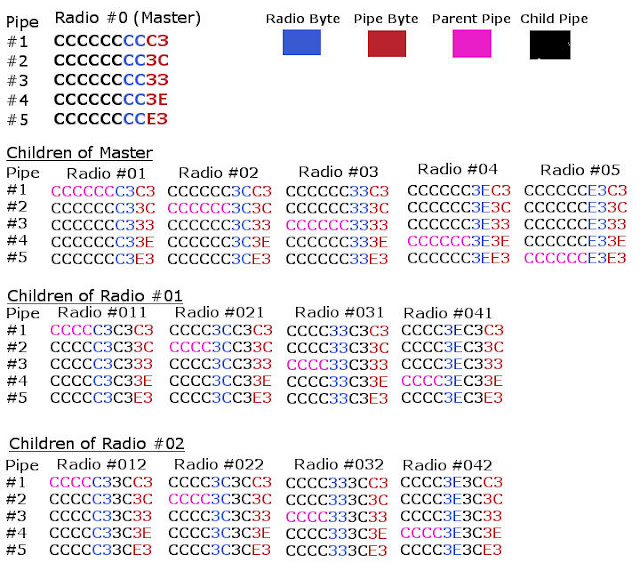RF24 Addressing: A review of NRF24L01+ radio addressing
Pipes, Addresses and Acknowledegments
There still seems to be a fair bit of questions, misconceptions and misunderstandings regarding the nature of RF24 radio addressing and how to set up communication scenarios. This is a review of RF24 pipes, addressing and acknowledgements that should provide any user with enough information to set up any supported configuration.
Acknowledgements (ACKs):
The radios support an automatic acknowledgement feature, enabled by default, in which the receiving radio switches into transmit mode after reception, and acknowledges reception of data.
1. A sends to B
2. B responds to A
3. A is now aware that B received the payload successfully
The acknowledgment process is very important to understand, because correct addressing is required for this feature to function properly.
Simplest Explanation/Rules of Addressing (Using ESB/Auto-Ack):
1. When using Auto-Ack, every radio can utilize a maximum of 6 unique addresses at once, which other radios can send data to.
2. Each address is assigned to a logical "pipe", and each radio has only 6 pipes that can be assigned addresses.
3. Since auto-ack implies a bi-directional communication channel, each address/pipe can only support communication to a single radio using acknowledgements. If two or more devices send data to a single pipe/address, auto-ack should be disabled to prevent ACK spamming and erroneous acknowledgements.
Exceptions:
a: Disabling Auto-Ack - This prevents excessive spamming of acknowledgements and errant acknowledgement.
b: Timing of Transmissions - Using a token-ring style network or other method of preventing simultaneous transmissions would allow multiple radios to send data to the same pipe/address while maintaining the reliability of acknowledgements.
Note: At 1MBPS, a transmission can take up to 85ms or so, and overlapping transmissions are likely with any significant traffic
4. Per manufacturer design, the addresses assigned to pipes 1-5 must be the same, except for a single byte.
Basic Scenario - One to One Communication with AutoAck:
For purposes of standardization and to allow the system to be scaled, it is generally recommended to use two radio addresses. With auto-ack disabled, a single address can be used for all radios, or groups of radios.

Code:
Radio #1:
byte address_1[] = {0xCC,0xCC,0xCC,0xCC,0xCC};
radio.openReadingPipe(1,address_1);
Radio #2:
byte address_2[] = {0xC3,0xCC,0xCC,0xCC,0xCC};
radio.openReadingPipe(1,address_2);
Process - Radio #1 sending to Radio #2:
1. Radio #1 opens pipe 0 for writing (and internally, reading) using address of Radio #2 (CCCCCCCCC3)
2. Radio #2 receives the data on the first attempt, and (internally) opens a writing pipe using its own address (CCCCCCCCC3) and sends an acknowledgement back to Radio #1
3. Radio #1 receives the ACK, so does not engage in a series of timed retries
Basic Scenario - One to One or Many to Many Communication with Multicast:
With AutoAck disabled, radios can share the same address, and the system can still be scaled to support any number of devices.

Code:
byte address_1[] = {0xCC,0xCC,0xCC,0xCC,0xCC};
radio.setAutoAck(0);
radio.openReadingPipe(1,address_1);
In this situation, any radio can send a message to all other radios sharing the same address:
Code:
radio.stopListening();
radio.openWritingPipe(address_1);
radio.write(&data,sizeof(data));
radio.startListening();
Simple Mesh Scenario - Five-to-Five Communication with AutoAck:

In the above scenario any radio can send or receive data from any other radio in the mesh, thus creating a 'true mesh' of 5 nodes.
Radio #1 will always open a writing pipe using the address assigned to pipe#1 of the recipient.
Radio #2 will always open a writing pipe using the address assigned to pipe#2 of the recipient.
Radio #3 will always open a writing pipe using the address assigned to pipe#3 of the recipient.
... and so on
Process Confusion:
In this example of addressing, if Radio#2 and Radio#3 were to both open a writing pipe to Radio#1 using the same pipe/address, there would be confusion with acknowledgements. Radio#1 will respond to both devices with acknowledgements, since they have both opened a writing and reading pipe using the same address.
Complex Network/Mesh Scenario - Many-to-Many Communication with AutoAck:

As can be seen, this format of addressing is very similar to creating sub-nets with IPV4 addressing, except here we are using HEX instead of decimals, and there are 5 bytes per address instead of 4. Each radio is linked as shown in the image below, and each radio has a unique communication channel (pipe/address combination) to use when communicating with any of its parent or child nodes.
Due to the correlation of addresses and associated topology, each radio only needs to be aware of its parent and child nodes. Any traffic sent to a given node will either be a: Accepted b: Routed to parent c: Routed to a child
Address configuration, routing etc, can be managed very simply by masking and bit-shifting.

In the above example, pipe0 is NOT assigned a reading address, leaving it available to be used for broadcast or multicast. With AutoAck disabled on a single pipe, or by using selective acknowledgements, all radios or groups of radios can share an address, thus all radios will receive all messages sent to that address.
See the RF24Network Documentation and Source Code for more information regarding this type of configuration.
Summary:
In many low-throughput situations, the radios will appear to function correctly even with improper addressing, and may not cause any obvious problems, however, performance and functionality will most certainly be affected.
In any situation where reliability and acknowledged payloads are important, proper addressing and an understanding of the underlying processes behind acknowledged payloads is very important.